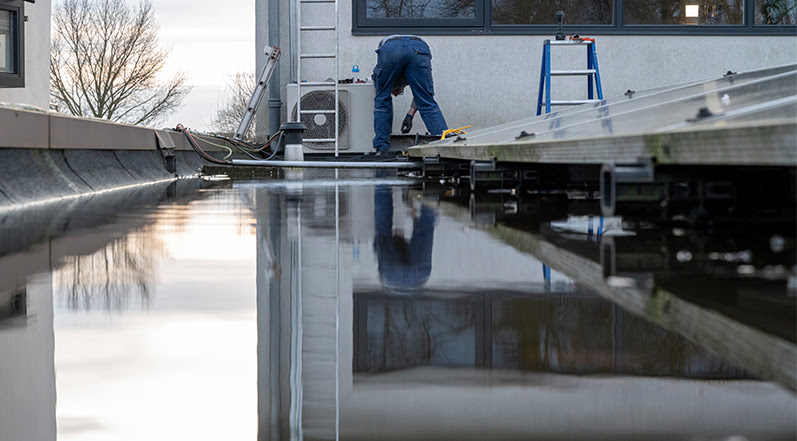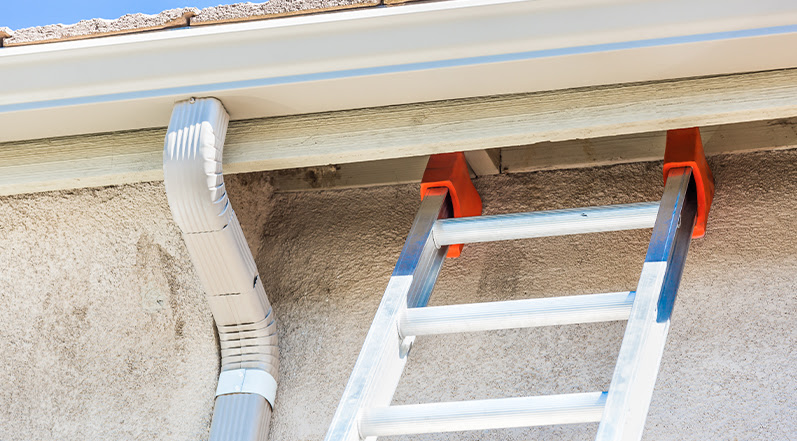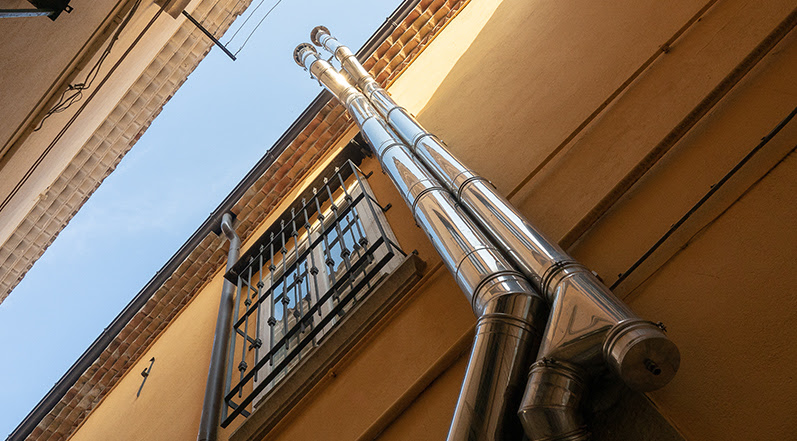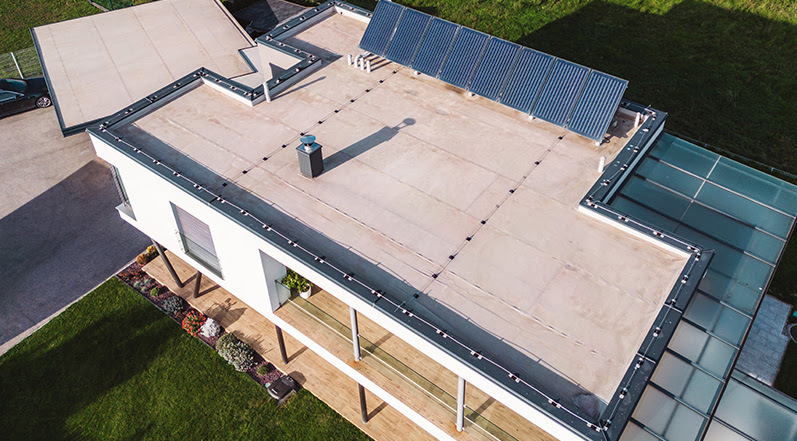- Home »
- Learningcenter »
- Ponding water flat roof
Ponding Water: Solutions for Flat Roof Drainage Issues

Flat roofs can have a hard time shedding water, and that's bad news for anyone who doesn't want leaks. Keeping water from pooling is important. Make it a habit to inspect the roof, clean up those gutters, and maybe pop in a few extra drains. A bit of a tilt towards the drains doesn't hurt either - it helps keep the water from hanging around.
Regularly cleaning your roof keeps it looking good and is a defense strategy against damage that can hit your wallet hard.
Basically, focusing on drainage and regular maintenance is a great way to extend your roof's life and make it clear of headaches later on.
Let's get started!
What Causes Ponding Water on Roofs?
Having a flat roof can sometimes mean you end up playing host to unwanted puddles of water. This is the weather throwing rain your way; it's also about how your roof is shaped and how much TLC you've been giving it. Let's talk about why this happens and what you can do about it.
So, picture this: you have rain, leaves, and maybe even water from your air conditioning unit all hanging out on your roof. That's a party you didn't intend to throw, and it can lead to water getting a little too comfy up there, which isn't great for the parts of your roof keeping your building safe and dry.
The shape of your roof is a big deal too. If it's not sloping just right or if the drains are playing hide and seek, water's going to grab. Over time, your building might settle into its foundations a bit like sinking into a comfy couch, which means more spots for water to collect.

The parts you've chosen for your roof and how they're holding up are part of the story as well. Say you've gone for rubber roofing but ended up with a patchwork quilt up there - that's not helping water find its way out. And if the insulation isn't what it used to be, your roof's slope might get a little wonky, which makes it harder for water to drain properly. Drains that are missing in action or not doing their job can turn a small issue into a big headache.
Then there's a heavy rain scenario. It's like your roof's drainage system is trying to drink from a fire hose - it can only handle so much. Staying on top of maintenance is your best bet here. Drains and gutters love to collect souvenirs; make sure they're not holding onto debris, and keep an eye out for any spots on your roof where water loves to hang out.
Getting to know how all these factors play together is your help in keeping water off the dance floor. A bit of proactive care and regular check-ups can go a long way in keeping your roof - and, therefore, your building - in great shape. I'm talking about fixing problems today and making sure your building is set for the future.
How Can Lack of Right Drainage Affect Your Roof?
Having water sit on your flat roof is no good - it spells trouble and can cut the life of your roof short.
Let me lay it out straight: when your roof's drainage isn't doing its job, that's when you're most likely to run into issues.
Keep an eye on your gutters, drains, and scuppers to keep them from getting blocked or failing. If your drainage can't keep up with the rain, you're going to end up with a rooftop pool. And let's be honest, no one wants that. Making sure your gutters are clear and your drains are free-flowing is important to keep your roof looking and performing its best.

Drain blockages are where the real headache starts. They set off a domino effect that's bad news for your roof's surface, shaving years off its life. And I'm talking about the water sitting up there; it's about what it does next - creeping in, looking for the weak spots, and maybe even causing some expensive leaks. If your roof isn't getting the TLC it deserves, it might start collecting debris, piling on the weight, and allowing all sorts of damage, like surface blisters, to happen.
The magic word here? Maintenance. Regular checks and care for your roof are non-negotiable.
Think about drainage when you're planning out your roof and keep that vigilance going with ongoing upkeep. Taking care of issues as soon as they pop up means your roof's drainage system will be in fighting form.
Why Is Regular Maintenance Important?
Keeping a solid, leak-free roof over your head means you have one less thing to worry about. Letting water hang out on your flat roof after a storm? Not a good idea. If it's still there after 48 hours, that's your wake-up call to get moving. Water logging can mess up your roof's surface, make it age faster, pop up blisters, and even become a magnet for dirt no one wants.
Make it a habit to check out your roof commonly. Keeping those gutters and drains clear is a big win against water damage.
When you're up there, playing detective for any minor issues can save you from major headaches later. Found a leak? Fix it fast. This way, your property stays in top shape, and your wallet doesn't feel the pinch from preventable repairs.

Setting up a regular roof-check schedule does more than extend its life; it might also be the great ticket to keeping your warranty in check. Miss out on those inspections? You might find yourself footing the bill for something the warranty would have happily covered.
Speaking from the heart, there's real comfort in knowing your roof is up to snuff. It means your property's protected, surprise repair bills are less likely to sneak up on you, and that peace of mind? Priceless!
Solutions to Improve Flat Roof Drainage
Managing water on flat roofs? The importance is in having the right drainage system in place. Think of strategically placing your drains to make sure water finds its way out efficiently. And remember to regularly check those drains and clear them of any gunk to keep things flowing smoothly.
Where flat roofs join hands with sloped ones, gutters become your best buddies. They're like the roadways for rainwater, directing it away through downspouts. Keeping these pathways clean is a must to prevent any water from hanging out where it shouldn't. And then there are scuppers - those little escape hatches along the roof's edges - working together with downspouts to keep the water moving off the roof.

Ever heard of the siphonic roof drain system? It's kind of cool because it uses a vacuum to zip water away through smaller pipes, meaning less clogging. But, like anything, it still needs a check-up now and then to keep it in great shape.
And if you have obstructions like vents or chimneys, throwing in roof crickets can be incredible. They're like the traffic cops directing water away, which makes sure smooth sailing for rainwater.
Talking about these options is a solid move for taking care of water management on flat roofs. Each strategy has its moment to shine, depending on what your roof is dealing with, all with the goal of keeping things nice and dry.
From my perspective, staying on top of these drainage systems has many uses beyond good advice; it's non-negotiable to keep them up and running over the long haul. A little bit of maintenance, like making sure those gutters and drains are debris-free, can go a long way in dodging water woes.
How Waterproof Membranes Help With Pooling
Keeping the rain out of buildings with flat roofs is a big deal, and that's where waterproof membranes come in. Think about options like TPO or PVC - they're like benefits shielding your roof from moisture. do they keep your building dry, but they're also pros at handling what the weather throws at them, from scorching sun to UV rays, and of course, lots of water.
These waterproof layers are tough, but they're not invincible. They really cut down on issues like the roof aging prematurely, seams weakening, or blisters popping up. Although they won't outright remove these problems, they're pretty good at reducing them.

A high-quality waterproof membrane is like giving your flat roof a personal trainer. With the right care, these systems bulk up your roof, which makes it stronger and ready to face more birthdays. It's a wise investment for anyone looking to keep their flat roof in great shape over the years.
Why do we care so much about waterproof membranes for flat roofs? Because they're important for locking out moisture and extending the life of your roof. Their knack for standing firm against tough weather means your flat roof can hang in there for the long haul.
Crushed Insulation and Roof Slope Issues
Flat roofs can be a bit of a hassle, especially when you start seeing water pooling up. It's common because the things underneath, which are supposed to keep your roof flat, have seen better days. This makes your heating or cooling less effective and throws a wrench into how water is supposed to run off.
The game plan? Get rid of those beat-up old parts and bring in the new, sturdy ones. Here's where it gets interesting - tapered polyisocyanurate, or let's call it tapered iso for short, is your favorite. This thing was built to add a bit of a slope to your roof so water and whatever else finds its way up there doesn't stick around but slides off towards drains or gutters.
Tapered iso comes in various thicknesses and slopes - think 1% or 2% - giving you the flexibility to find just the perfect fit for your roof's needs.

Choosing the right slope and planning out the layout - that's a big deal. Understanding your roof's current status, figuring out the slope you need, and how to make sure water finds its way to the drains efficiently. Planning and execution are important.
Keep in mind, in spots where people are always walking, tapered iso alone won't cut it. You'll want to add some protection to keep it in great shape so it can do its job well for the long haul.
From my experience, tapered iso is a solid pick for finishing insulation woes on flat roofs. Creating those slopes for effective water drainage makes sure your roof stays in great condition and keeps your space comfy temperature-wise. Surely, it is a solution worth considering for those flat roof challenges.
Preventative Measures and Long-Term Strategies
Stopping water from collecting on flat roofs and planning for the future are important steps to ensure building safety. It starts with a well-thought-out roof design that includes a slight slope and strategic placement of drains to avoid issues. Part of this is basically choosing quality roofing parts and regular maintenance - both are super important for keeping your roof in good condition.
This technique allows for early detection of any problems before they worsen.

Talking to roofing experts regularly is also a good idea, if you haven't had your roof looked at yet. They update property owners on the latest roofing techniques and parts to prevent water from pooling. Schedule inspections can find and address hidden problems early, avoiding larger issues in the future. Proactive roof maintenance keeps flat roofs in good shape, focusing on staying informed and prepared.
At Colony Roofers, we specialize in commercial and residential roofs in Georgia, Florida, and Texas. We are the favorite for issues with water on flat roofs. Letting our pros handle your roofing needs protects your investment and will ensure your safety. Choosing Colony Roofers means getting expert advice, repair, and installation services. Contact us today for a free inspection and experience our commitment to quality roofing. If you have any questions, please feel free to let us know! We'd be more than happy to help you out.
 Call (678) 365-3138
Call (678) 365-3138



